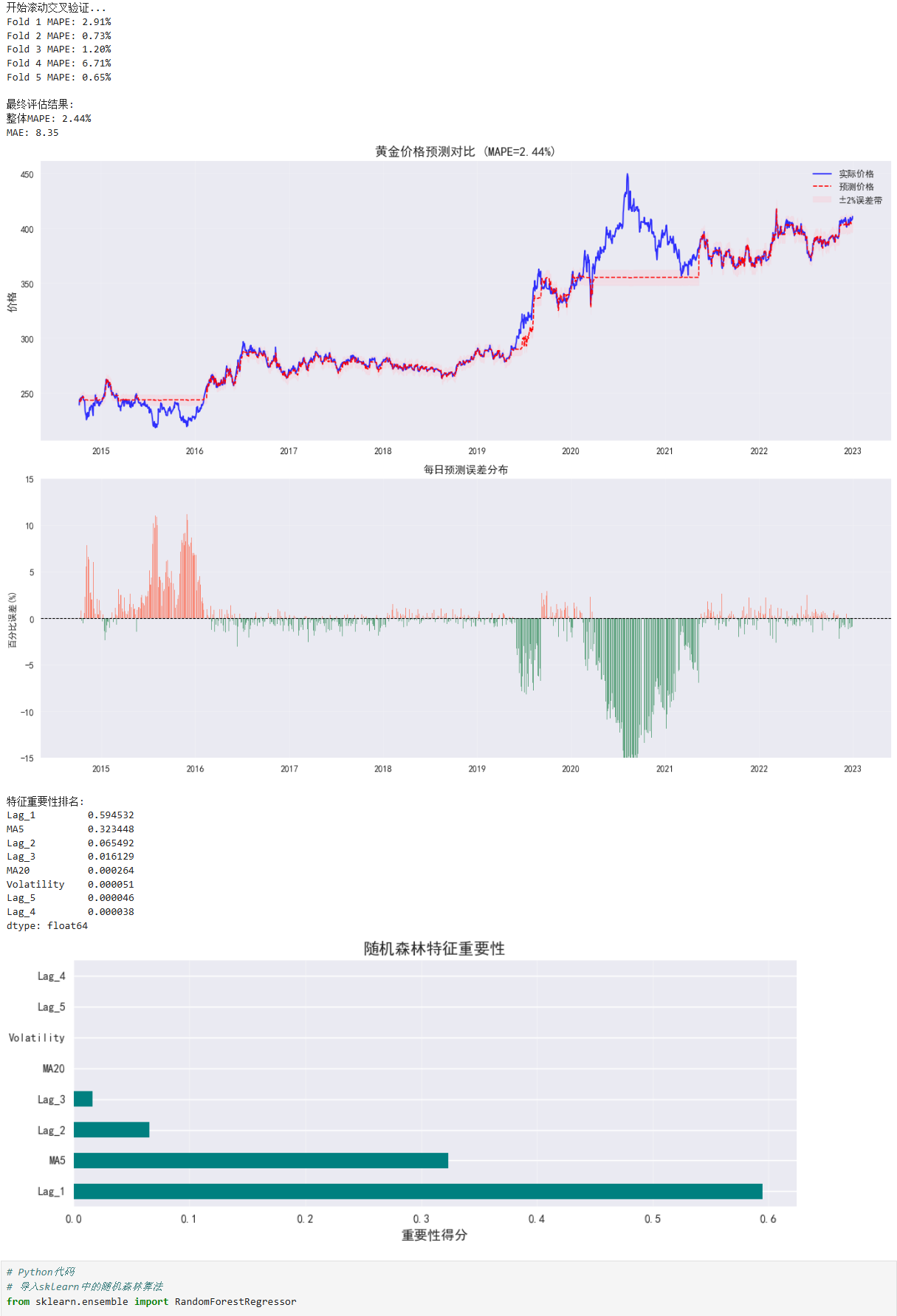AI使用随机森林算法建模
编辑
4
2025-06-27

提示词
以日期为index的DataFrame,包含一列收盘价数据,需要使用其前5个交易日的收盘价作为特征,当日收盘价作为预测目标,用随机森林算法建模,并用滚动时间序列交叉验证评估模型,计算其MAPE,最后将真实值与预测值进行可视化,请给出示例代码。
答案
import numpy as np
import pandas as pd
import matplotlib.pyplot as plt
from sklearn.ensemble import RandomForestRegressor
from sklearn.model_selection import TimeSeriesSplit
from sklearn.metrics import mean_absolute_error
# =====================
# 1. 数据准备与特征工程
# =====================
# 假设df是包含日期索引和收盘价的DataFrame
# 示例数据生成(替换为实际数据)
# dates = pd.date_range(start='2020-01-01', end='2025-06-27', freq='B') # 交易日
# prices = np.cumsum(np.random.randn(len(dates)) * 10 + 1800) # 模拟黄金价格
# df = pd.DataFrame({'收盘价': prices}, index=dates)
df = pd.read_excel('黄金连续.xlsx')
#将日期设置为index,并只保留收盘价
df.set_index('日期', inplace=True)
df = df[['收盘价']]
# 创建滞后特征(前1-5个交易日收盘价)
for lag in range(1, 6):
df[f'Lag_{lag}'] = df['收盘价'].shift(lag)
# 添加技术指标特征
df['MA5'] = df['收盘价'].rolling(5).mean().shift(1) # 5日移动平均(避免泄露)
df['MA20'] = df['收盘价'].rolling(20).mean().shift(1) # 20日移动平均
df['Volatility'] = df['收盘价'].pct_change().rolling(10).std().shift(1) # 波动率
# 目标变量(当日收盘价)
df['Target'] = df['收盘价']
# 删除包含NaN的行
df_clean = df.dropna().copy()
features = [f'Lag_{i}' for i in range(1, 6)] + ['MA5', 'MA20', 'Volatility']
# =====================
# 2. 滚动时间序列交叉验证
# =====================
tscv = TimeSeriesSplit(n_splits=5) # 5折时间序列分割[6](@ref)
predictions = []
actuals = []
dates_list = []
mape_values = []
print("开始滚动交叉验证...")
for fold, (train_index, test_index) in enumerate(tscv.split(df_clean)):
# 严格按时间顺序划分数据[2,5](@ref)
train_data = df_clean.iloc[train_index]
test_data = df_clean.iloc[test_index]
# 训练随机森林模型
model = RandomForestRegressor(
n_estimators=100,
max_depth=5,
random_state=42,
n_jobs=-1
)
model.fit(train_data[features], train_data['Target'])
# 预测并存储结果
fold_preds = model.predict(test_data[features])
predictions.extend(fold_preds)
actuals.extend(test_data['Target'].values)
dates_list.extend(test_data.index)
# 计算当前fold的MAPE(过滤零值)
mask = test_data['Target'] != 0
if sum(mask) > 0:
fold_mape = np.mean(np.abs((test_data.loc[mask, 'Target'] - fold_preds[mask]) /
test_data.loc[mask, 'Target'])) * 100
else:
fold_mape = 0
mape_values.append(fold_mape)
print(f"Fold {fold+1} MAPE: {fold_mape:.2f}%")
# =====================
# 3. 评估指标计算
# =====================
results = pd.DataFrame({
'Date': dates_list,
'Actual': actuals,
'Predicted': predictions
}).set_index('Date').sort_index()
# 整体MAPE计算(安全处理零值)
mask = results['Actual'] != 0
overall_mape = np.mean(np.abs((results.loc[mask, 'Actual'] - results.loc[mask, 'Predicted']) /
results.loc[mask, 'Actual'])) * 100
mae = mean_absolute_error(results['Actual'], results['Predicted'])
print("\n最终评估结果:")
print(f"整体MAPE: {overall_mape:.2f}%")
print(f"MAE: {mae:.2f}")
# =====================
# 4. 可视化分析
# =====================
plt.figure(figsize=(14, 10))
# 4.1 价格曲线对比
plt.subplot(2, 1, 1)
plt.plot(results.index, results['Actual'], 'b-', label='实际价格', alpha=0.8, lw=1.5)
plt.plot(results.index, results['Predicted'], 'r--', label='预测价格', lw=1.2)
plt.fill_between(results.index,
results['Predicted'] * 0.98,
results['Predicted'] * 1.02,
color='pink', alpha=0.3, label='±2%误差带')
plt.title(f'黄金价格预测对比 (MAPE={overall_mape:.2f}%)', fontsize=14)
plt.ylabel('价格', fontsize=12)
plt.legend()
plt.grid(alpha=0.2)
# 4.2 误差分布分析
plt.subplot(2, 1, 2)
errors = (results['Predicted'] - results['Actual']) / results['Actual'] * 100
plt.bar(results.index, errors,
color=np.where(errors >= 0, 'tomato', 'seagreen'),
alpha=0.7, width=1)
plt.axhline(0, color='black', ls='--', lw=0.8)
plt.title('每日预测误差分布', fontsize=12)
plt.ylabel('百分比误差(%)', fontsize=10)
plt.ylim(-15, 15)
plt.grid(alpha=0.2)
plt.tight_layout()
plt.savefig('gold_price_forecast.png', dpi=300)
plt.show()
# 4.3 特征重要性分析
feature_importance = pd.Series(
model.feature_importances_,
index=features
).sort_values(ascending=False)
print("\n特征重要性排名:")
print(feature_importance)
plt.figure(figsize=(10, 4))
feature_importance.plot(kind='barh', color='teal')
plt.title('随机森林特征重要性', fontsize=14)
plt.xlabel('重要性得分', fontsize=12)
plt.grid(axis='x', alpha=0.3)
plt.tight_layout()
plt.show()
图像:

- 0
- 0
-
赞助
 支付宝
支付宝
 微信
微信
-
分享
